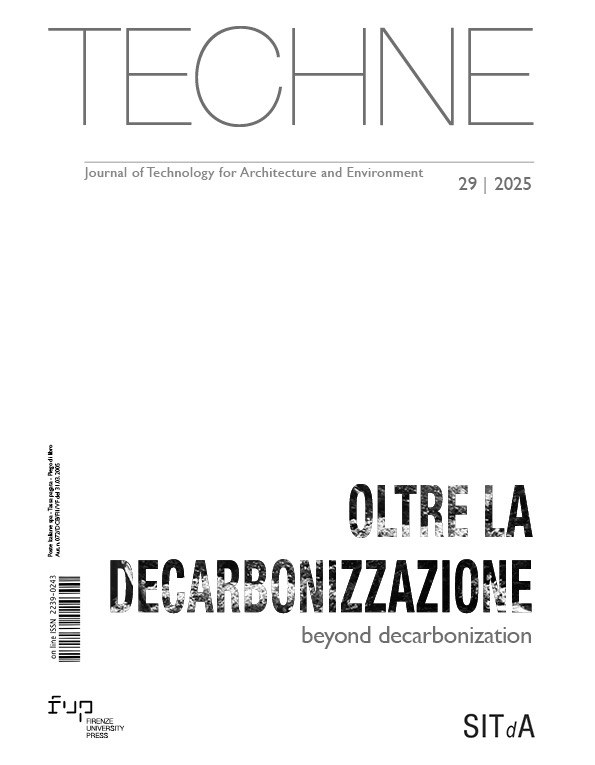Climate conscious design of light structures for improving the liveability of urban environments
Published 2025-07-31
Keywords
- Climate change,
- Optimisation,
- Morphogenesis,
- Parametric design,
- Digital fabrication
How to Cite
Copyright (c) 2025 Rossella Siani, Francesco De Luca

This work is licensed under a Creative Commons Attribution 4.0 International License.
Abstract
A climate-neutral urban environment can benefit from light structures that provide relief from urban overheating in warm seasons, reduce surface temperatures, and lower energy needs and carbon emissions while sequestering carbon through bio-based materials. This research introduces a temporary architectural system to enhance thermal comfort year-round in urban spaces. Combining parametric design with computational morphogenesis, the system optimises shading and airflow to reduce summer heat stress while retaining solar radiation in winter. The modular structure integrates visually with its surroundings without obstructing views. Climate simulations and a 1:30 scale prototype confirm its feasibility, offering a sustainable, adaptable solution for diverse urban climates and contributing to climate-responsive design.
Downloads
References
- Asato, A. (2018), Pavilions as Urban Placemakers: Temporary Architecture and Community Engagement, University Honors Theses, Paper 536, Portland State University, PDXScholar, Portland. Available at: https://doi.org/10.15760/honors.541 (Accessed on 29/11/2024). DOI: https://doi.org/10.15760/honors.541
- Bröde, P., Jendritzky, G., Fiala, D., and Havenith, G. (2010), “The Universal Thermal Climate Index UTCI in Operational Use”, Proceedings of Conference Adapting to Change: New Thinking on Comfort, Windsor, UK, April 9-11, 2010, pp.1–6. Available at: https://utci.org/resources/windsor_vers05.pdf (Accessed on 29/11/2024).
- De Luca, F. (2017a), “Solar collection multi-isosurface method: Computational design advanced method for the prediction of direct solar access in urban environments”, Proceedings of CAAD Futures 2017, Istanbul, Turkey, July 12-14, 2017, Communications in Computer and Information Science, Vol. 724, pp. 170-187. Available at: https://link.springer.com/chapter/10.1007/978-981-10-5197-5_10 (Accessed on 29/11/2024). DOI: https://doi.org/10.1007/978-981-10-5197-5_10
- De Luca, F. (2019a), “Sun and wind: integrated environmental performance analysis for
- building and pedestrian comfort”, Proceedings of the 10th Annual Symposium on Simulation for Architecture and Urban Design SimAUD 2019, Atlanta (GE), USA, April 7-9, 2019, Simulation Series, Volume 51, Issue 8, pp. 3–10. Available at: https://dl.acm.org/doi/10.5555/3390098.3390099 (Accessed on 29/11/2024).
- De Luca, F. (2017b), “From Envelope to Layout. Buildings Massing and Layout Generation for Solar Access in Urban Environments”, Sharing Computational Knowledge! ShoCK!, Proceedings of the 35th International Conference eCAADe, Rome, Italy, September 20-22, Vol. 2, pp. 431-440. Available at: https://papers.cumincad.org/data/works/att/ecaade2017_164.pdf (Accessed on 29/11/2024). DOI: https://doi.org/10.52842/conf.ecaade.2017.2.431
- De Luca, F. (2019b), “Environmental Performance-Driven Urban Design: Parametric Design Method for the Integration of Daylight and Urban Comfort Analysis in Cold Climates”, Proceedings of CAAD Futures 2019, Daejeon, South Korea, July 26-28, 2019, Communications in Computer and Information Science, Vol. 1028, pp. 15-31. Available at: https://link.springer.com/chapter/10.1007/978-981-13-8410-3_2 (Accessed on 29/11/2024). DOI: https://doi.org/10.1007/978-981-13-8410-3_2
- Eslamirad, N., Sepúlveda, A., De Luca, F. and Sakari Lylykangas, K. (2022), “Evaluating Outdoor Thermal Comfort Using a Mixed-Method to Improve the Environmental Quality of a University Campus”, Energies, Vol. 15, n. 4, 1577. Available at: https://doi.org/10.3390/en15041577 (Accessed on 29/11/2024). DOI: https://doi.org/10.3390/en15041577
- Gatto, E., Buccolieri, R., Aarrevaara, E., Ippolito, F., Emmanuel, R., Perronace, L. and Santiago, J.L. (2020), “Impact of Urban Vegetation on Outdoor Thermal Comfort: Comparison between a Mediterranean City (Lecce, Italy) and a Northern European City (Lahti, Finland)”, Forests, Vol. 11, n. 2, 228. Available at:. https://doi.org/10.3390/f11020228 (Accessed on 29/11/2024). DOI: https://doi.org/10.3390/f11020228
- Naboni, E., Siani, R., Turrini, M., Touloupaki, E., Gherri, B. and De Luca, F. (2023), “Experiments on Microclimatically adapt a courtyard to climate change”, IOP Conference Series: Earth and Environmental Science, Vol. 1196, 012032. Available at: https://iopscience.iop.org/article/10.1088/1755-1315/1196/1/012032 (Accessed on 29/11/2024). DOI: https://doi.org/10.1088/1755-1315/1196/1/012032
- Oxman, R. and Oxman, R. (2014), Theories of the Digital in Architecture, Routledge, New York. Available at: https://www.routledge.com/Theories-of-the-Digital-in-Architecture/Oxman-Oxman/p/book/9780415469241 (Accessed on 29/11/2024).
- Pugnale A. and Sassone, M. (2007), “Morphogenesis and structural optimization of shell structures with the aid of a genetic algorithm”, Journal of the International Association For Shell And Spatial Structures, Vol. 48, n. 3, pp. 161-166. Available at: https://www.researchgate.net/publication/271522718_Morphogenesis_and_Structural_Optimization_of_Shell_Structures_with_the_Aid_of_a_Genetic_Algorithm#fullTextFileContent (Accessed on 29/11/2024).
- Rota, P., Gravante, A. and Zazzi, M. (2019), “Urban Heat Island (UHI) risk maps as innovative tool for urban regeneration strategies. The case of Parma”, IOP Conference Series: Earth and Environmental Science, Vol. 296, 012034. Available at: https://iopscience.iop.org/article/10.1088/1755-1315/296/1/012034 (Accessed on 29/11/2024). DOI: https://doi.org/10.1088/1755-1315/296/1/012034
- Santamouris, M. (2014), “Cooling the cities – A review of reflective and green roof mitigation technologies to fight heat island and improve comfort in urban environments”, Solar Energy, Vol. 103, pp. 682–703. Available at: https: //doi.org/10.1016/J.SOLENER.2012.07.003 (Accessed on 29/11/2024). DOI: https://doi.org/10.1016/j.solener.2012.07.003
- Santamouris, M. (2015), “Regulating the damaged thermostat of the cities – Status, impacts and mitigation challenges”, Energy and Buildings, Vol. 91, pp. 43–56. Available at: https://doi.org/10.1016/J.ENBUILD.2015.01.027 (Accessed on 29/11/2024). DOI: https://doi.org/10.1016/j.enbuild.2015.01.027
- Santamouris, M. (2020), “Recent progress on urban overheating and heat island research. Integrated assessment of the energy, environmental, vulnerability and health impact. Synergies with the global climate change”, Energy and Buildings, Vol. 207, 109482. Available at: https://doi.org/10.1016/J.ENBUILD.2019.109482 (Accessed on 29/11/2024). DOI: https://doi.org/10.1016/j.enbuild.2019.109482
- Siani, R. (2020), “Materiali Naturali – Progettazione Generativa. Dall’antitesi alla sintesi”, In Perriccioli, M., Rigillo, M., Russo Ermolli, S. and Tucci F. (Eds.), Design in the Digital Age. Technology Nature Culture | Il Progetto nell’Era Digitale, Tecnologia Natura Cultura, Maggioli Editore. Available at: https://www.sba.unifi.it/upload/policy-oa-2016-1.pdf (Accessed on 01/02/2025).
- Siani, R. (2023), “Algorithm Morphogenesis by Solar Parameters and Model Fabrication of a Temporary Architecture”, Proceedings of eCAADe RIS 2023, Tallinn, Estonia, June 15-16, 2023, pp. 183-188. Available at: https://papers.cumincad.org/data/works/att/ecaaderis2023_52.pdf (Accessed on 29/11/2024).
- UN-Habitat (2023), Urban Energy, United Nations Human Settlements Programme, Nairobi, Kenya. Available at: https://unhabitat.org/topic/urban-energy (Accessed on 29/11/2024).






